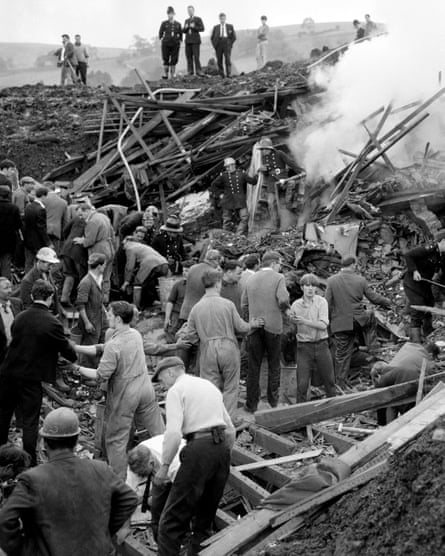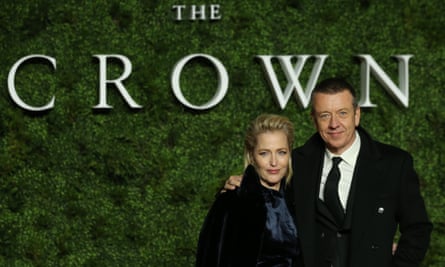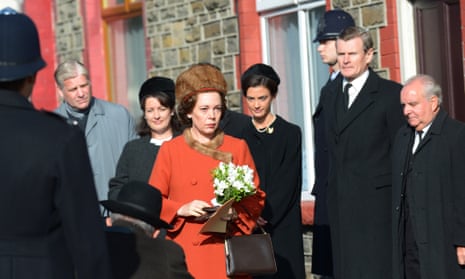One of the sets built for the new series of The Crown on a backlot at Elstree Studios was held in sombre reverence by both actors and crew. Between the model of the gilded gates of Buckingham Palace and a mock-up of 10 Downing Street lay a bleak pile of brick, coal dust and rubble: a replica of the school in the Welsh village of Aberfan that was destroyed in 1966.
The decision to portray the catastrophe, in which 116 children and 28 adults were killed after the collapse of a mining waste tip, was made by writer Peter Morgan when he first drew up plans for the hit television show. But making the episode last year forced him to face up to the distortions of historical drama more seriously than before, he told the Observer.
“The production team made spectacular efforts to show respect and consideration,” he said. “But I underestimated how raw it still was. The best you have to rely on is your conscience and your own belief in what the truth is.”
Those relatives and neighbours who took up an invitation from the producers to appear as extras in some scenes were also offered counselling for the first time in 53 years. And there will be more to come.
“We had a therapist to help all the people who were recreating such a horrific scene,” said producer Oona O Beirn. “People who live there are still traumatised, of course, and we found they’d never been offered help before. Now we are trying to arrange more.”

Before filming began in the nearby village of Cwmaman, the producers also held a well-attended public meeting. “It was a surprise,” said head researcher Annie Sulzberger.
“We had slightly dreaded it, but in fact people wanted to tell their stories and to ask about the new cast,” said O Beirn.
The team also learned of the male voice choir that was formed after the disaster and used them in the episode.
Ahead of the release of the latest series on Netflix, producer Suzanne Mackie said the third episode, dealing with Aberfan, almost stands alone. “Of all the different stories The Crown has done so far, this was most difficult in terms of our duty of care. But it is true to the spirit of all we learned.”
The appalling tragedy that October day was met with a period of national mourning, but it also became a crisis for the monarchy. The Queen’s failure to appear promptly on the scene was judged a mistake.
“There have been remarkably few hiccups in her long reign but that was a regret she felt, so I had always known we were going to cover it if we were commissioned to continue the show,” said Morgan. “It can only compare to the days that followed Diana’s death, the ones I dealt with in the film The Queen. That moment came as salt in a wound: the earlier idea she had not shown emotion about Aberfan.”
News interviews with Aberfan families more recently show that many still recall the Queen’s public show of sympathy with gratitude. Contradictions like this highlight how hard it is to agree on the facts, Morgan finds.
“It shows the way our idealised, emotional memory shapes all history,” he said. “When I did the research for the film Frost/Nixon, most of those involved were still alive, but their versions of what happened were wildly different. It is a bargain I have had to make with myself as a writer. I need to make sense of it all in some way.”
Tackling Aberfan posed poignant dilemmas about storytelling, but it also raised significant questions for Morgan about the nature of the monarchy. “It asks what we want of our royal family. I don’t think we can make up our minds as a nation, and in our indecision, we torture them,” said the writer.

National affection for the Queen, played now by Olivia Colman, rests “partly on her longevity and partly on her own persona”, Morgan believes. “There is a steadfastness and what you can call a calming presence.”
All the same, Morgan recognises that he can never really access what he calls the monarch’s “internal journey”. “What we can see, though, is an emotional reticence, and then wonder if that has come about programatically, or whether she was born with something missing. Perhaps the process of separating out Elizabeth Windsor from Elizabeth Regina has damaged her? I have always thought the danger of being Queen is losing sight of who you are because you have to do certain things automatically, as the crown. So how much is her and how much is the crown; that is the question. And how much is the cost?”
Morgan went on to contrast the Queen with her son. “Restraint comes more naturally to her than to Charles, who is a front-foot kind of person who wants to contribute,” he said.
In 1966, the monarch’s apparent stoicism served as a model for the people of Aberfan. Surviving children returned to school two weeks later. There was no counselling, and newspapers praised the villagers for apparently getting back to normal life.
The Crown’s researchers drew up a complete timeline of the 10 days following the tragedy from news reports and personal accounts. “They really all cared about telling us the details and we fed it all back,” said O Beirn. “We even weighed up whether or not they had sung All Things Bright and Beautiful at school as usual that day,” added Sulzberger.
Next Morgan and the producers had to decide how to tell it. The plan was to justify each decision to bend a fact. There had been a terrible fog that day, they knew well, but there was no good way to show the disaster through fake fog on the Elstree set. Later, too, Prince Philip is shown at a funeral he did not really attend because it was judged necessary to have a central character in each key scene.
“One of the surviving children, the last pulled out, gave us a vivid visual memory of seeing a shaft of light and ash blowing above his head,” said O Beirn. “But we had to drop the scene. We had listened to him, though, and could explain why.”
Many of the production team, including O Beirn, who is Irish, and Sulzberger, an American, had not previously known about Aberfan. “Somehow that made us feel it was all the more important to let people know,” said O Beirn.
“We all had to become experts in it…to work out what a tip slide really was and what it looked like,” said Sulzberger.
The episode, they hope, will inform those who have no knowledge of the tragedy and also tell the story for those who have lived with it ever since.
